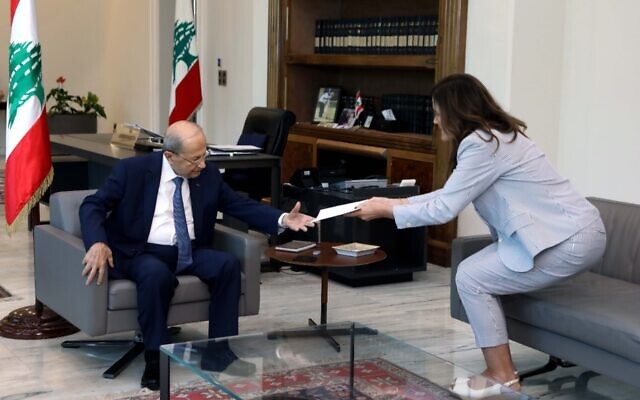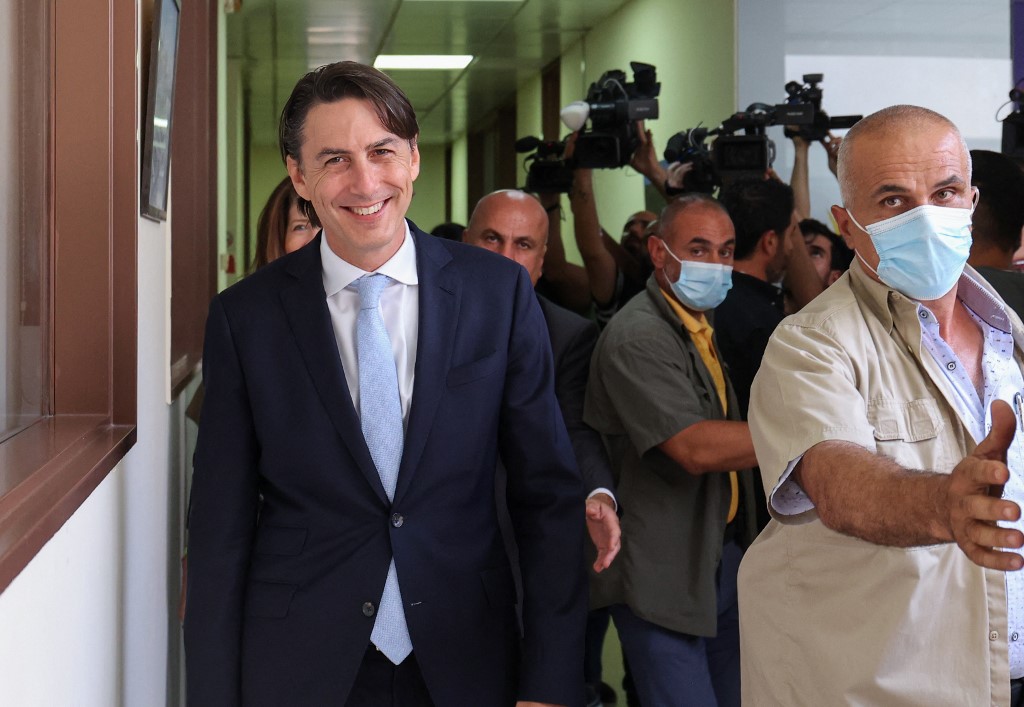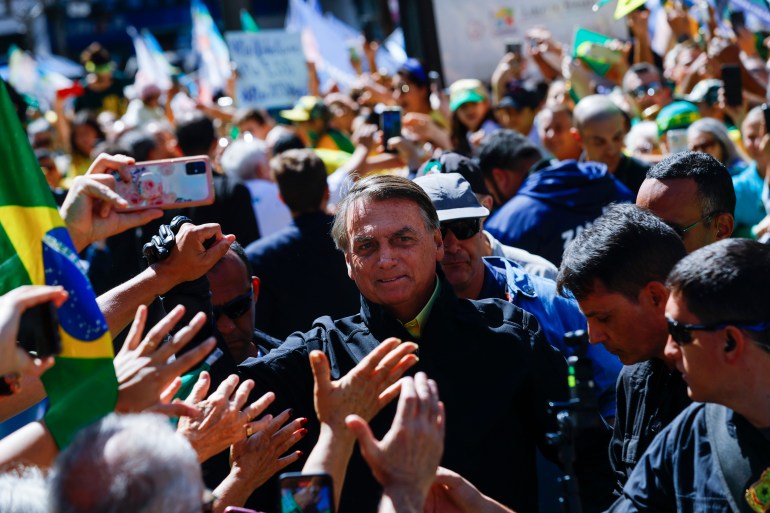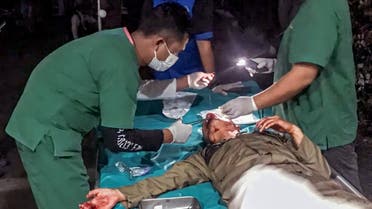STORY SEPTEMBER 27, 2022
GUEST
Iranian American writer and community organizer living in Chicago and the Bay Area.
LINKS"Iranian women are rising up to demand freedom. Are we listening?"
Hoda Katebi on Twitter
Dozens of people in Iran have been killed in a series of escalating women-led protests demanding justice for Mahsa Amini, a 22-year-old Kurdish woman who died in the custody of the so-called morality police. Amini was detained on September 13 for allegedly leaving some of her hair visible in violation of Iran’s hijab law. Iranian American writer Hoda Katebi calls the protests “exciting and beautiful,” bringing together women from across economic and ethnic backgrounds and opening up conversations about the policing of women’s bodies. She says the government is using the protests to “advance nationalist ideas,” crack down on Kurdish communities and propel a false narrative of an uprising against Islam. Katebi’s recent piece for the Los Angeles Times is titled “Iranian women are rising up to demand freedom. Are we listening?”
Transcript
This is a rush transcript. Copy may not be in its final form.
AMY GOODMAN: We begin today’s show in Iran, where dozens of people have been killed in a series of escalating women-led protests demanding justice for a 22-year-old Kurdish Iranian woman named Mahsa Amini, who died in the custody of Iran’s so-called morality police. Amini was detained on September 13th for allegedly leaving some of her hair visible in violation of an Iranian law requiring women to cover their head. Witnesses said Amini was severely beaten in a police van. She died after falling into a coma.
Her death has sparked the largest protests Iran has seen since at least 2019. The Norway-based group Iran Human Rights estimates 76 people have been killed over the past two weeks. At least 1,200 have been arrested. According to the Committee to Protect Journalists, at least 20 journalists have been arrested covering the protests. Communication remains limited to parts of Iran due to internet and social media shutdowns. Meanwhile, Iran’s Revolutionary Guard attacked areas in northern Iraq Monday populated by Iranian Kurdish separatists.
To talk more about the protests, we’re joined in Chicago by Hoda Katebi. She’s an Iranian American writer, community organizer, living in Chicago and the Bay Area. Her new op-ed in the Los Angeles Times is headlined “Iranian women are rising up to demand freedom. Are we listening?”
Welcome, Hoda, to Democracy Now!
HODA KATEBI: Thank you so much for having me.
AMY GOODMAN: Describe the extent — can you describe the extent of these women-led protests and how radical it is that it is women, and particularly young women, who are not only the spark for these protests but also the ones in the streets?
HODA KATEBI: Absolutely. Absolutely. What we’re seeing in Iran right now is really exciting and beautiful. It’s terrifying, but I think that’s just the nature of people’s movements, as we see around the world.
I do want to say that these movements right now are absolutely led by women, but as have all of the previous movements in Iran. Women have always sort of played a central role within movement spaces in Iran, both before and after the revolution. And so what we’re seeing now is actually the natural culmination not only of women continuously taking up leadership within systems change in Iran, but also decades of state repression against women, and particularly focused on women’s bodies in public spaces.
But what is especially unique about this moment right now is that not only are young women — and we’re seeing this for the first time — their bravery is really, really energizing and exciting and inspiring — really on the frontlines, just being faced with all types of different government repression, from internet censorship to live ammunition to plastic bullets, and also these sets of protests have a bit of a more intersectional approach to them.
The central demand that women are chanting is for “Women! Life! Freedom!” which originally is a Kurdish slogan, actually, and has now been translated into Farsi and popularized across the country. And we see in the streets workers are coming out alongside students, Kurdish women, non-Kurdish women. And we see a lot of sort of a greater — a greater amount of Iranians from across class background coming together to demand both justice for Mahsa Amin, the abolition of the Gasht-e-Ershad, or the so-called morality police, and all of the systems that uphold it, and the state, as well.
JUAN GONZÁLEZ: And, Hoda, could you talk about how the Iranian government has exerted pressure and repression on the Kurdish community over the years?
HODA KATEBI: Absolutely. The Iranian government has been extremely repressive in these protests, as have they been in previous protests, as well, too. Right now, for example, we’re seeing live ammunition used. Dozens of Iranians have been killed. A 10-year-old girl was killed in Karaj, which is a suburb of Tehran, only days ago.
And there has been a particular emphasis on the Kurdish area where Mahsa, or Zhina, Amini was originally from. This area has been sort of the heart and the initial sparking outlet of these protests nationwide. And now we’re seeing sort of an immense pressure that the government is posing on the Kurdish community and sort of using this as an opportunity to really advance a lot of the sort of nationalist ideals of the Iranian project onto the Kurdish communities.
JUAN GONZÁLEZ: And there’s been a particular role by the Basij volunteers in Iran’s paramilitary Revolutionary Guard. Can you talk about their role and who they are?
HODA KATEBI: Right. So, the Basij are part of the Iranian government’s sort of apparatus of shutting down protesters. What’s also significant is that these sort of paramilitary guards are also being stationed in places like ambulances or other places that — as we also see, I think, very parallels the United States’s approach in repressing protesters here, is that they’ll use everyday sort of like civil society objects. So, we’re seeing a lot of images, for example, of ambulances on fire or other sorts of things that seem like very related to civil society, but we also are seeing a very particular tactic of using these items in order to have sort of images of ambulances on fire being the videos that are circulating and sort of shaping the narratives, when in fact there’s so much more to that story.
There’s also a lot of plainclothes Basijis within sort of the protesters who are trying to push specific narratives that allow the state to sort of advance its violence against the protesters. So, for example, there’s a lot of narratives right now that the Iranian government is trying to push, is that this is a uprising or a protest against Islam; it’s against hijab; it’s not about the right to choose, but it’s about Islam at large. And these are extremely, extremely terrifying to see this sometimes also picked up by people outside of Iran, because as Iranian woman on the ground are fighting for is the right to choice and the right to freedom across the board. This is beyond just women’s rights, and it’s about state violence. And I think that would — kind of making this about Islam and making this about Muslims would actually isolate the millions of Iranian women in Iran and around the world who are Muslim, who wear the hijab, who don’t wear the hijab, who are also in solidarity or on the frontlines of these protests.
AMY GOODMAN: I was wondering if you can talk about, well, I mean, the actual — what the women are doing, ripping off their headscarves, even burning them, men cheering them on. Can you talk about this kind of brazen defiance and what this means for the so-called morality police, and the fact that these protests are extending to religious cities, for example, like Qom?
HODA KATEBI: Absolutely. I think that there are so many powerful, beautiful images coming out of Iran right now. And as someone who does wear the hijab and has chose to wear the hijab for most of my life, I think, as an Iranian American, seeing images of Iranians in Iran who have been forced to wear the hijab, like, burning their headscarves, I think, actually, is such a beautiful and powerful symbol, because the Iranian government has chosen to adopt this headscarf as its national symbol to enforce on women’s bodies in Iran. And so, what we’re seeing is actually women rising up and burning symbols of the state that have been historically enforced on their bodies. And so, I think that this is a really, really powerful example that I think people around the world can really learn from in terms of taking up items that the state has decided is a symbol of itself. Of course, these are very contextualized. And I also want to underscore that several times, because an Iranian in Iran who has been forced to wear the hijab by the state burning a headscarf is very different than, say, Pompeo in the United States burning a hijab in his house on Twitter. So, I also think that the context around this is very, very important.
And I think that this also speaks to why this protest in this moment has been so beautifully spread and we’ve seen so much international solidarity, is because women are really on the frontlines and demanding that this moment open up a greater conversation, not just about, like, morality police and mandatory dress codes, but actually the intersections of socioeconomic class on women’s bodies, labor justice, economic justice, and really talking about progress and moving forward on a systemic level and that there should be no gender delay in that conversation.
AMY GOODMAN: Also amazing to see them cutting their hair. World-renowned Oscar-winning Iranian filmmaker Asghar Farhadi released a video calling on artists around the world to declare their solidarity with the protesters in Iran.
ASGHAR FARHADI: This society, especially these women, has traveled a harsh and painful path at this point. And now they have clearly reached a landmark. … I deeply respect their struggle for freedom and the right to choose their own destiny, despite all the brutality they are subjected to. … Through this video, I invite all artists, filmmakers, intellectuals, civil rights activists from all over the world and all countries, everyone who believes human dignity and freedom, to stand in solidarity with the powerful and brave women and men of Iran by recording video or writing or any other way.
JUAN GONZÁLEZ: Hoda, your response to this support from other sectors of society? And also, the issue of the level of surveillance by the morality police? You wrote in the L.A. Times that, quote, “Earlier this month the government announced it will start using facial recognition technology in public spaces to enforce dress codes against women”?
HODA KATEBI: Absolutely, yes. And I definitely uplift those words by Asghar Farhadi, that I think that was a very beautiful call to stand in solidarity with Iranian women and also recognize that these struggles are connected globally.
And I think, especially when it comes to things like surveillance, you know, so we see an increased level of state surveillance of women’s bodies in particular in Iran in order to enforce dress code. And this is something that we’ve actually been seeing increase specifically these past several years under the Raisi administration, that have also sort of imposed a new fining system for ticketing women for different dress code violations. And so, this has definitely been part of a larger trajectory that has, especially in these past few years, really worsened the cracking down on women’s bodies in public spaces in Iran.
AMY GOODMAN: This is the Iranian president, Ebrahim Raisi, responding to the protests.
PRESIDENT EBRAHIM RAISI: [translated] They want to ride a wave and create riots and disturbances. They think, with such moves, they can stop the nation. We have announced many times that if anyone has a fair comment, we will listen to it. But anarchy, disturbing national security, the security of people, no one will succumb to this.
AMY GOODMAN: I was wondering if you can respond, if you’re talking really here about a civil war, the protests escalating. Also, Christiane Amanpour expected to interview him in New York. He just addressed the U.N. General Assembly. She refused to wear a headscarf, said she would in Iran — she is Iranian — but not here. And he canceled the interview.
HODA KATEBI: I think it’s hard to feel anything other than just absolutely outraged when you see — when you hear his words. And I think what is particularly, I think, especially important, I think, for someone like myself, who is very used to hearing that being said by U.S. presidents whenever there are massive protests across the country, for example, after the death of George Floyd, and I think that this is just a common state tactic to focus on sort of things that are happening in the fringes or the marginalized parts of a movement, and not actually centering the voices.
I think that there have been women, there have been people talking about these issues, civil society organizations that have been bringing these issues forward for decades. For decades, since the revolution, people have been talking about this. So I think it would be absolutely ludicrous to say that this is the first time that hijab has been a conversation in Iran, when this has actually been at the forefront of conversations, along with how it’s connected to class and the economic situation in Iran, the treatment of ethnic minorities in Iran. And we actually saw a lot of that increase when there was a surge of Afghan refugees to Iran after the U.S. botched withdrawal in Afghanistan. So, I think these conversations have always happened.
In fact, on the contrary, we have seen a sort of reduction of spaces to be able to have these conversations. Civil society organizations have come out in full fledge against the Gasht-e-Ershad and the systems that uphold it, and they have — and many that have been working on these issues before have either been forced to close, the leaders of nonprofits, of organizations in Iran have been banned from working. And so, I think that this is sort of a tipping point of escalated sort of both these sorts of state — specifically state restrictions that have — the crackdown has worsened, as well as an increase of closure of spaces to be able to talk about this, outside of protesting on the streets.
AMY GOODMAN: We just have 30 seconds, Hoda.
HODA KATEBI: And also — oh, go ahead.
AMY GOODMAN: And that is, your thoughts on calls for increased sanctions against Iran?
HODA KATEBI: It is the most ironic, for lack of a better word, term, because sanctions kill people. Sanctions have killed Iranian women. And we can just look to the history of our neighbor of Iraq to understand how devastating sanctions are. Iranian women’s call for women, life and freedom, as I’ve mentioned, reached to the economic sector, and United States sanctions have played a major role on crippling the Iranian economy. Right now Iran is also at a moment of some of its worst economic situations since the revolution, and this is directly tied to U.S. sanctions, as well, too.
And so, if anything, Iranian women just want — and Iranians at large — the United States to have no interference in this, and that includes removal of all sanctions on Iran, that have historically been there. We’ve seen a little bit about this, when Biden has removed some of the sanctions around telecommunications, that have enabled the Iranian government to have a monopoly on the censorship of Iranian voices. And so, we urge sort of Biden to continue to remove sanctions off of Iran, so that America has no interference and that Iranians on the ground become the agents of their own futures on their own terms.
AMY GOODMAN: Hoda Katebi, we want to thank you so much for being with us, Iranian American writer, community organizer, living in Chicago and the Bay Area. We’ll link to your piece in the Los Angeles Times, “Iranian women are rising up to demand freedom. Are we listening?”
Next up, we go to Baltimore. The Kushner company agrees to pay at least $3 million to settle claims of shoddy apartments and rent abuses. Then we’ll go to Philadelphia. Stay with us.
[break]
AMY GOODMAN: “Bella Ciao,” the classic Italian ANTI-FASCIST protest song, being sung in Persian by an Iranian woman in a video that’s gone viral online as part of nationwide protests.




















